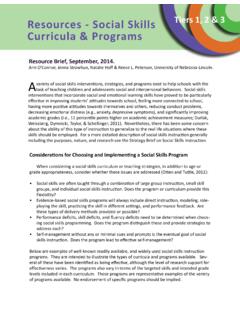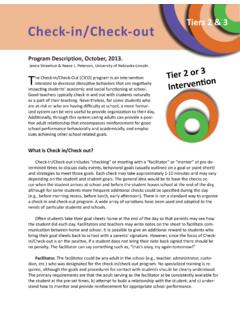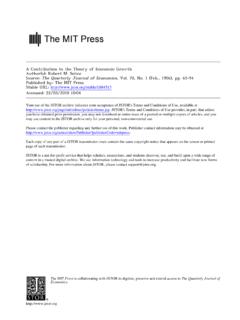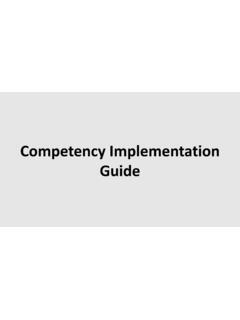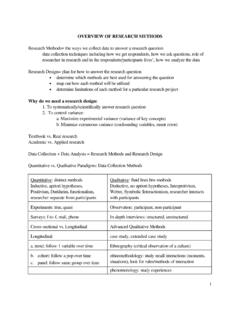Transcription of Pyramid Model for Early Tiers 1, 2, & 3 Childhood Education
1 Pyramid Model for Early Childhood EducationTiers 1, 2, & 3cessful from the very beginning. Supporting the social and emotional develop-ment of preschoolers has gained significant atten-tion in the past 20 years, and recently, research-ers found that expulsion rates of preschoolers are higher than that of elementary and secondary students (Fox & Hemmeter, 2009; Gilliam, 2014). The issue with expelling young children is that it eliminates their chance to learn appropriate, desired behaviors that will prepare them for their future Education . When children are removed from the classroom it is more difficult to imple-ment evidence-based strategies (Lewis, Adam-son, Mitchell, & Lembke, 2013) and the nega-tive effects of these practices have come to the attention of the Departments of Health and Human Services and Education (2014a, 2014b).
2 Challenging behavior is an issue for many young children. Approximately 10% to 15% of typi-cally developing preschoolers have behavior problems when they enter kindergarten (Campbell, 1995; West, Denton, & Germino-Hausken, 2000). Unfortunately, the percentage is higher for children living in poverty and for children with disabilities (Hemmeter, Ostrosky, & Fox, 2006). In addition, longitudinal researchers showed that about 50% of children who displayed external-izing behaviors in preschool continued to display these problem behaviors in later school years (Campbell, 1995). Therefore, promoting positive social-emotional competence in all children and intervening before social-emotional difficulties escalate is important for children to be suc-Furthermore, Early Childhood teachers and caregivers encounter a wide range of behaviors in preschool-age children and many public preschool programs serve children who are already at-risk for behavior problems due to a disability or low socio- economic status (Lewis et al.)
3 , 2013). Moreover, many Early Childhood teachers and caregivers report feeling unprepared to deal with such a wide variety of challenging behaviors. This is supported by a finding that only 10% of the children who displayed severe challenging behavior received appropriate supports for such difficulties (Kazdin & Kendall, 1998). Additionally, a later study found that between 30% and 40% of students who entered kindergarten did not possess the social and emotional skills needed to succeed in school (Stage, 2005). Further, even though school drop out is a concern with high school students, the best way to prevent it is to provide children with positive school experiences at the beginning of their Education (National Dropout Prevention Center/Network, 2011).Strategy Brief, August, 2016 Allison Heifner, University of Nebraska-Lincoln, Jan Thelen, Retired, Nebraska Department of Education , Christine Marvin & Emily Dorsey, University of Nebraska-Lincoln, Teresa Berube, Nebraska Department of Education , Ana Damme, & Reece Peterson, University of Nebraska-Lincoln.
4 Tiers 1, 2, & 3 Building & Sustaining Student EngagementPyramid Model for Early Childhood 2 Acknowledging and reinforcing positive child behavior, Directly teaching social skills, expecta-tions, and behaviors to children related to different environments, Monitoring children s challenging be-haviors, and Teaching positive replacement Model incorporates the ongoing collection and use of teacher, classroom, child and family data for decision-making regarding children s response to intervention, and employs team-based decision making. What is the Pyramid Model ?The Teaching Pyramid Model , more re-cently referred to as the Pyramid Model , is a comprehensive, multi-tiered framework of evidence-based practices that promote the social, emotional, and behavioral develop-ment of young children (Hemmeter, Ostrosky, & Corso, 2012).
5 The Pyramid Model focuses on promoting positive behavior and addressing challenging behavior (Hemmeter et al., 2012). The following strategies are emphasized in the effective practices:Relationship to PBIS and RTI. The Pyramid Model is the Early Childhood Model for Positive Behavior Interventions and Supports (EC-PBIS) and for Response to Intervention (RTI), which have been implemented at the K-12 levels (Fox, Carta, Strain, Dunlap, & Hemmeter, 2009). It is based on the same underlying principles, practices, and strategies as PBIS and RTI, but is implemented and taught in a way that is developmentally appropriate for young chil-dren in Early care and Education programs. It is designed as a program-wide intervention and should be implemented with fidelity to provide positive environments and promote engage-ment for all children.
6 Fox and Hemmeter (2009) hope that, like PBIS, the Pyramid Model can be used as a framework for instruction and behavior management in preschool settings. Overall, researchers say that the focus of a PBIS framework in Early Childhood settings should be on the promotion of social and emotional development and the prevention of challeng-ing behavior for all young children (Fox, Dunlap, Hemmeter, Joseph, & Strain, 2003).Applicable ages and programs. Although the Pyramid Model was designed for programs Building & Sustaining Student EngagementPyramid Model for Early Childhood 3 Retrieved from: 1. The Pyramid Modelserving 3 and 4-year olds, the research-based strategies are not limited to use in this age group. The practices have been adapted in many states for use in child care programs and homes for children birth to age five, and have been adapted and extended into K-3 classrooms.
7 Establishment of the Pyramid Model . The Pyramid Model was developed in collabora-tion between two federally funded research and training centers. These are the Center for the Social and Emotional Foundations for Early Learning (CSEFEL) funded by the federal Of-fice of Head Start and Child Care ( ), and the Technical Assistance Center on Social Emotional Intervention (TAC-SEI) funded by the federal Office of Special Education Programs ( ). Both centers are now consolidated under the umbrella of the national Pyramid Model Consortium ( ). Their aim has been to disseminate Pyramid research and evidence-based teaching practices to Early Childhood programs across the Underlying Principles of the Pyramid Model The Pyramid Model proposes practices iden-tified through a review of researched strategies to promote and enhance the social-emotional development of children.
8 The practices are or-ganized in a multi-tiered system of support. The Model employs a Pyramid to represent the tiered system of supports (See Figure 1).Building & Sustaining Student EngagementPyramid Model for Early Childhood 4 Some of the principles used in the Pyramid Model , such as specifying clear expectations and providing positive reinforcement for appro-priate behaviors, are well-known as evidence-based strategies for increasing desired behavior. In addition, the Pyramid Model implements teacher practices which have been shown to lead to positive social and behavioral outcomes for young children. Some of these practices include, actively supporting children s play, responding to children s conversations, promot-ing the communicative attempts of children with language delays and disabilities, providing specific praise to encourage appropriate be-havior, developing positive relationships with children and families, and collaborative teaming with colleagues and other professionals (Fox & Hemmeter, 2009, p.)
9 6-7). Tiered Approach The Pyramid Model describes four Tiers of practice, adding an underlying foundational level, which ad-dresses issues related to the Early Childhood workforce and training needed to support the following Tiers . Devel-oping, implementing, and reviewing the foundational level is necessary to sustain the intervention practices over time. The Pyramid Model builds on a public health ap-proach to provide universal supports to all children to promote wellness, targeted support to those who need additional help, and intensive interventions to those who need them ( ). The Tiers of intervention serve as the framework through which intervention decisions are made. Within each tier of intervention, research-based teach-ing practices and supports are outlined for edu-cators to implement in Early Childhood settings.
10 The Tiers of intervention help prioritize the type and intensity of behavioral interventions that students receive (Fluke & Peterson, 2013).Foundational level. The foundation for all of the practices in the Pyramid Model are the systems and policies necessary to ensure a workforce able to adopt and sustain these evi-dence-based practices. Early care and Education environments and teacher/caregiver skills are diverse and vary widely. An effective workforce that includes well-trained teachers, professional collaboration, shared decision-making and posi-tive relationships between teachers, parents, caregivers, and any specialists are essential to prevent and address challenging behavior across all settings associated with an individual child. This is a necessary support system for the three Tiers of intervention to be implemented effectively and with fidelity.




